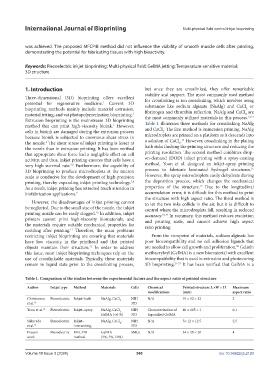Page 368 - IJB-10-3
P. 368
International Journal of Bioprinting Multi-physical field control inkjet bioprinting
was achieved. The proposed MFCPIB method did not influence the viability of smooth muscle cells after printing,
demonstrating the potential for fabricating tissues with high bioactivity.
Keywords: Piezoelectric inkjet bioprinting; Multi-physical field; GelMA jetting; Temperature-sensitive material;
3D structure
1. Introduction but once they are crosslinked, they offer remarkable
stability and support. The most commonly used method
Three-dimensional (3D) bioprinting offers excellent for crosslinking is ion crosslinking, which involves using
potential for regenerative medicine. Current 3D substances like sodium alginate (NaAlg) and CaCl or
1
bioprinting methods mainly include material extrusion, fibrinogen and thrombin reflection. NaAlg and CaCl are
2
material jetting, and vat photopolymerization bioprinting. the most commonly utilized materials in this process. 13,14
2
2
Extrusion bioprinting is the mainstream 3D bioprinting
method that can print high-viscosity bioink. However, Table 1 illustrates three methods for crosslinking NaAlg
3
cells in bioink are damaged during the extrusion process and CaCl . The first method is immersion printing. NaAlg
2
because bioink is subjected to enormous shear stress in microdroplets are printed on a platform as it descends into
15
the nozzle. The shear stress of inkjet printing is lesser at a solution of CaCl . However, crosslinking in the plating
4
2
the nozzle than in extrusion printing. It has been verified bath risks flushing the printing structure and reducing the
that appropriate shear force had a negligible effect on cell printing resolution. The second method combines drop-
activity, and thus, inkjet printing ensures that cells have a on-demand (DOD) inkjet printing with a spray-coating
very high survival rate. Furthermore, the capability of method. Yoon et al. designed an inkjet-spray printing
5,6
16
3D bioprinting to produce microdroplets at the micron process to fabricate laminated hydrogel structures.
scale is conducive for the development of high-precision However, the spray microdroplets easily dehydrate during
printing, thereby expanding inkjet printing technology. 7,8 the deposition process, which changes the mechanical
17
As a result, inkjet printing has attracted much attention in properties of the structure. Due to the longitudinal
biofabrication applications. accumulation error, it is difficult for this method to print
9
the structure with high aspect ratio. The third method is
However, the disadvantages of inkjet printing cannot to let the two inks collide in the air, but it is difficult to
be neglected. Due to the small size of the nozzle, the inkjet control where the microdroplets fall, resulting in reduced
printing nozzle can be easily clogged. In addition, inkjet accuracy. 18,19 In summary, this method reduces resolution
10
printers cannot print high-viscosity biomaterials, and and printing scale, and cannot achieve high aspect
the materials require suitable mechanical properties for ratio printing.
molding after printing. Therefore, the main problems
11
restricting inkjet bioprinting are ensuring that materials From the viewpoint of materials, sodium alginate has
have low viscosity in the printhead and that printed poor biocompatibility and no cell adhesion ligands that
20
objects maintain their structure. In order to address are needed to allow cell growth and proliferation. Gelatin
12
this issue, most inkjet bioprinting techniques rely on the methacryloyl (GelMA) is a new biomaterial with excellent
use of crosslinkable materials. Typically, these materials biocompatibility that is used in extrusion and photocuring
remain in liquid state prior to the crosslinking process, 3D bioprinting. 21-23 It has been verified that GelMA is a
Table 1. Comparison of the studies between the experimental factors and the aspect ratio of printed structure
Author Inkjet type Method Materials Cells Chemical Printed structure L ×W × H Maximum
modifications (mm) aspect ratio
Christensen Piezoelectric Inkjet–bath NaAlg, CaCl 2 NIH N/A 19 × 12 × 12 2
et al. 15 3T3
Yoon et al. 16 Piezoelectric Inkjet–spray NaAlg, CaCl 2 NIH Characterization of 40 × 105 × 1 0.1
GelMA (≈6 %) 3T3 Saponified GelMA
Sakurada Piezoelectric Inkjet– NaAlg, CaCl , 2 NIH N/A 5× 12 × 12.5 2.5
et al. 18 intersecting 3T3
Present Piezoelectric MFCPIB GelMA SMCs N/A 34 × 20 × 20 4
work method (3%, 5%, 10%)
Volume 10 Issue 3 (2024) 360 doi: 10.36922/ijb.2120

